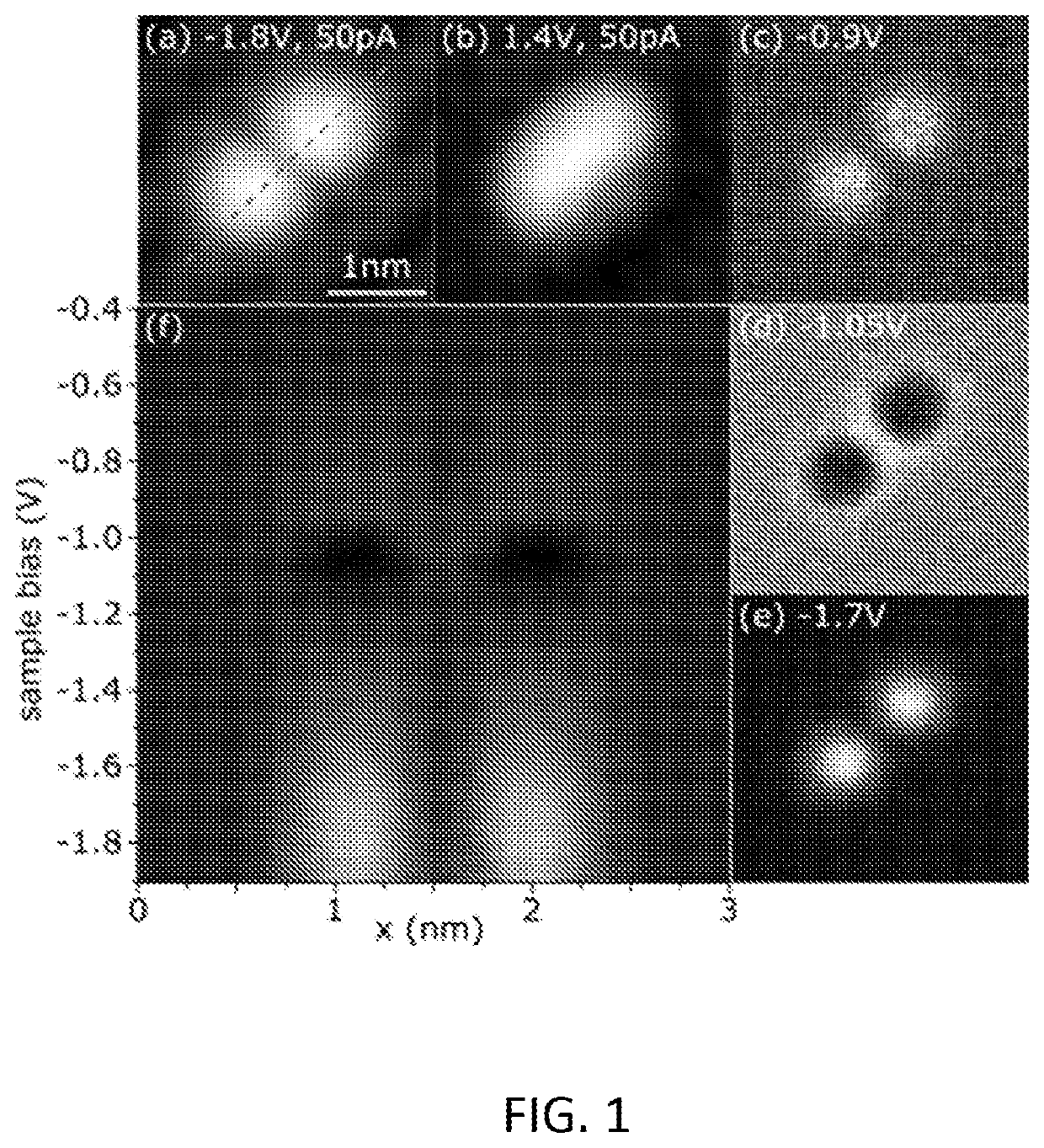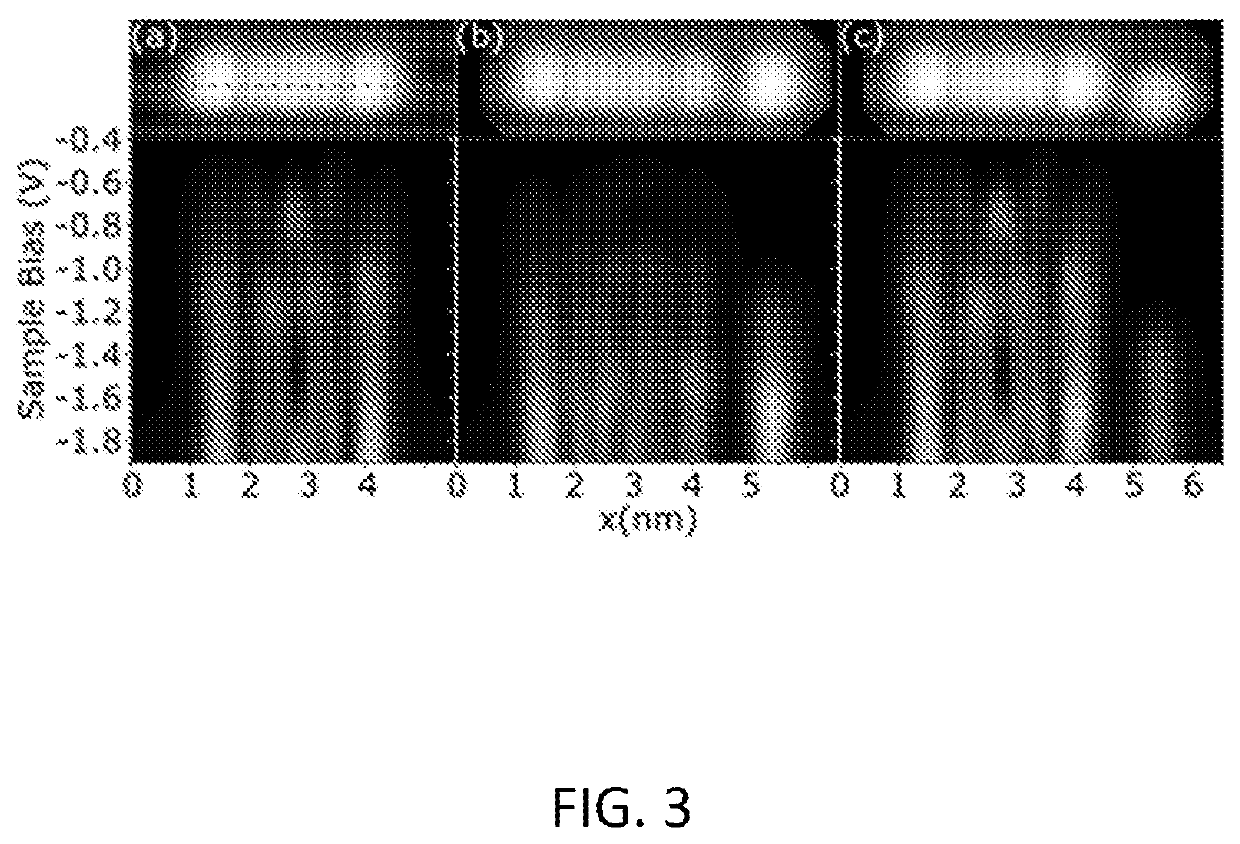Multiple silicon atom quantum dot and devices inclusive thereof
a quantum dot and silicon atom technology, applied in the field of multi-dangling bonds, can solve the problems of difficult to overcome limitations, difficult to direct observation of mechanically induced covalent bonding of two different atoms using nc-afm, and difficult to overcome challenges preventing practical applications
- Summary
- Abstract
- Description
- Claims
- Application Information
AI Technical Summary
Benefits of technology
Problems solved by technology
Method used
Image
Examples
example 1
[0081]FIG. 1 shows various characterisations of a linear 3 DB MSiAQD formed along one side of a dimer row on the Si(100) H terminated surface.
[0082]The large dI / dV vs position graphic conveys much information about the energy and spatial distribution of local state density. In other words, it shows where electrons are localized, and not, at each energy probed.
[0083]At most energies, strikingly, little state density is observed at the central atom position. This is a great and clear departure from the single ASiQD result. It clearly shows the emergent molecule like spectroscopy of the ensemble resulting from quantum mechanical overlap of atomic like orbitals.
[0084]Close space DBs form substantial electron sharing bonds. The newly emergent electronic structure is observed in multiple modes of imaging with a scanning tunneling microscope (STM). Spatially point specific dI / dV spectra show pronounced changes indicating new electronic structure. Whole 2D images of dI / dV, taken at a specif...
example 2
[0103]This experiment shows the ability to form more complex and advanced atom scale electronic structures from multiple ASiQDs according to further embodiments of the present invention. Such structures have utility in binary computation or atomic binary logic.
[0104]FIG. 6A shows a constant current STM image of an ASiQD created by tip-induced desorption of a single hydrogen atom from the H—Si(100) surface. At relatively high voltages (e.g. −1.7 V), the negatively charged ASiQD appears in filled states images as a bright protrusion surrounded by a characteristic small dark halo (17). In the corresponding frequency shift map at 0 V (FIG. 6D)), hydrogen atoms decorating underneath silicon atoms appear as bright protrusions arranged in the 2×1 surface reconstruction. The ASiQD shows up as a dark feature indicating a much higher tip-sample attractive interaction (19).
[0105]FIG. 6C shows I(V) spectroscopy curves taken above the ASiQD and H—Si surface, with both the surface and ASiQD showi...
experiment 3
reating an ASiQD
[0119]Inventive ASiQDs are formed using an inventive process in which vertical manipulation of a single H atom using the tip of an AFM sensor and its application in characterizing and engineering silicon DB-based structures of relevance to nanoelectronic devices. Following a localized tip induced excitation on the Si—H surface, a single hydrogen atom is desorbed and may be either deposited on the surface with stable imaging in STM and AFM, or transferred to the tip apex. The single H atom functionalized tip is identified through a unique signature in frequency shift vs. displacement curves (i.e. Δf(z)) and a characteristic enhancement of STM images in filled and empty states. By bringing the H-functionalized tip apex very close to a DB in the absence of bias and current, a covalent bond between the single hydrogen and silicon atoms is formed. Subsequent changes in the STM images and Δf(z) curves confirm that this mechanically induced reaction results in the passivati...
PUM
 Login to view more
Login to view more Abstract
Description
Claims
Application Information
 Login to view more
Login to view more - R&D Engineer
- R&D Manager
- IP Professional
- Industry Leading Data Capabilities
- Powerful AI technology
- Patent DNA Extraction
Browse by: Latest US Patents, China's latest patents, Technical Efficacy Thesaurus, Application Domain, Technology Topic.
© 2024 PatSnap. All rights reserved.Legal|Privacy policy|Modern Slavery Act Transparency Statement|Sitemap



